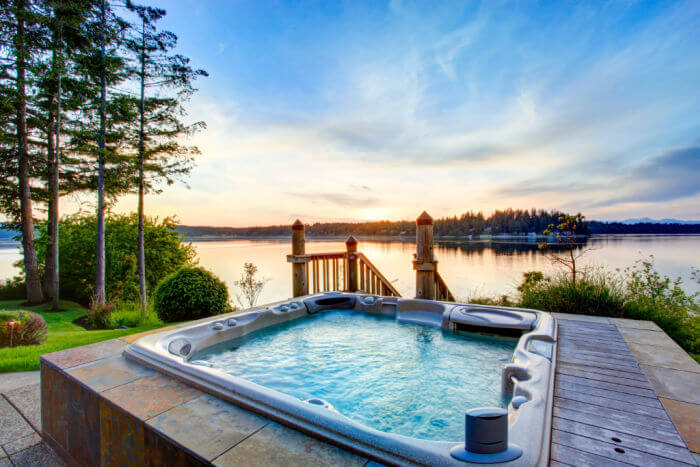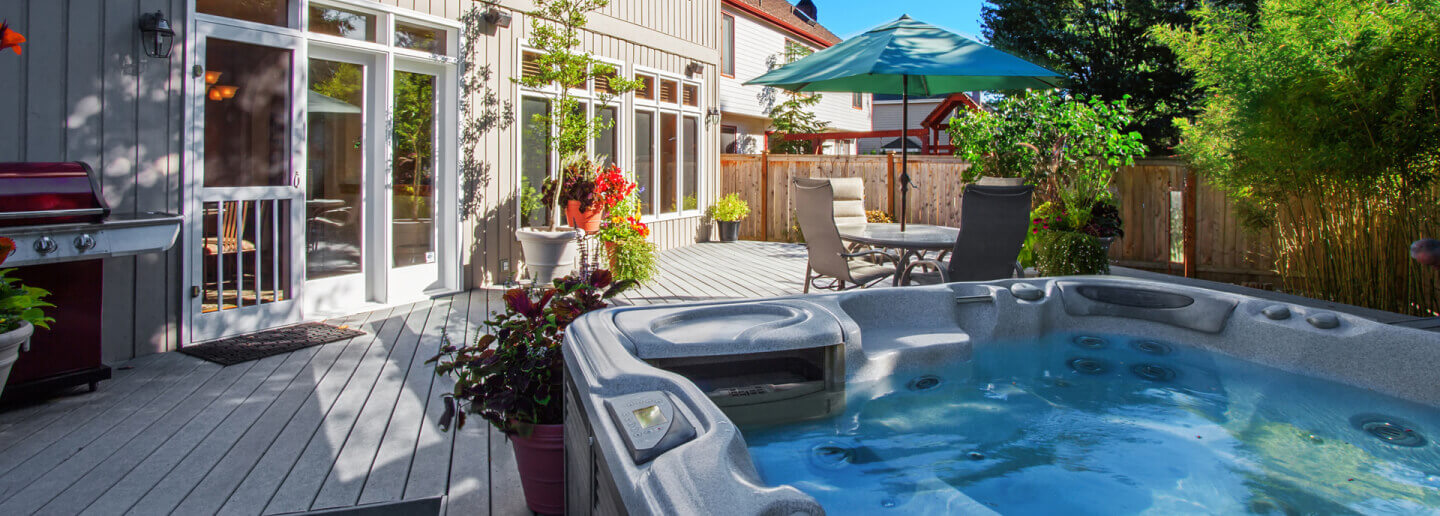Are Hot Tub Installations Worth It?
There are more than a few good reasons to invest in a hot tub installation for your property. There are millions of hot tubs in households in the U.S. alone – in fact, the APSP reports that out of 125 U.S. households, about 5.8 million homeowners have installed a hot tub. Hot tubs, sometimes called spas or jacuzzi spas, last for a very long time –up to 20 years or more. This longevity means that many new homeowners find themselves inheriting a hot tub from the previous owners. But much of that number also includes those who have chosen to partake in all the benefits newly installed hot tubs have to offer.
A hot tub is a good investment for those who want to add a relaxing and therapeutic element to their home, but do not want to sink the money or maintenance into a full-sized pool. Though some hot tub spas are in-ground, most hot tubs are above-ground, made of an acrylic or fiberglass shells and surrounded by handsome cabinets. Cabinets can be created of a variety of materials, such as wood or synthetic stone. Hot tubs often sit on a level concrete pad poured specifically for that purpose. Alternatively, they can be placed on a deck or patio that has been leveled or reinforced to accommodate the weight of the hot tub.
Many considerations go into the purchase and installation of a new hot tub. Homeowners should consider practical matters such as choosing the right location, ensuring functional plumbing and electrical connections, and determining the proper level base for the size of that particular tub. There are also the more personal choices, such as the features you want or the price point you need. Modernize is happy to help walk you through the process of choosing the right hot tub for your property.
How Much Does a Hot Tub Spa Cost?
There are many points to consider when it comes to the cost of hot tubs. The size, cover, shell material, number of jets and pumps, size of the heater, and much more come into play.
Upfront installation costs
In terms of upfront installation costs for a new hot tub, there are some basic price ranges you can expect:
- Small hot tubs for 2 to 3 people: $3,000 to $5,000
- Medium hot tubs for 5 to 7 people: $5,000 to $12,000
- Large hot tubs for 8 to 10 people: $9,000 to $20,000
Keep in mind that these are the base prices for materials. Installation fees may be involved depending on your hot tub installer and your geographical area. However, luckily installation for most hot tubs is usually inexpensive. This is especially the case if it is an above-ground model and there is already a suitable concrete pad, patio, or other level surface that can support the weight.
Upkeep and Maintenance Costs
All hot tub spas need to be maintained properly and cleaned routinely, which involves ongoing costs after paying for installation. Maintenance costs for hot tubs include the increase in your electric bill, which should be modest with smaller spas.
Keep in mind that hot tubs are usually more expensive to heat during the winter than summer. The more you use it during any season, the more you will run the heater. There will also be the cost of basic monthly cleaning and maintenance, including water filtration and chemicals. Water care systems that are built into the hot tub can involve a higher up-front price tag, but a lower monthly cost. All in all, most homeowners see about a $25-$50 increase in monthly utility bills depending on how often they use the hot tub. Hot tub service professionals will charge about $100-$150 per monthly visit to maintain, clean, and treat your hot tub’s water with chemicals.
What are the Benefits of a Hot Tub Spa?
Though hot tubs are well-known for their recreational use, there are other therapeutic reasons to add one to your backyard, pool area, or even a dedicated area inside your home. The benefits of a hot tub installation include:
- Relaxation. Anyone who has ever slipped into a warm bath can attest to the relaxation the hot water can provide. Add in hydrotherapy massage jets and the constant warm temperature, and feeling tense muscles relax is a given.
- Better Sleep. As your temperature drops after a good soak, your body relaxes into a state that can provide much better sleep.
- Improved Mobility. According to the Arthritis Foundation, time in a hot tub can improve quality of life. Taking advantage of warm water two or three times a week can help individuals move around better and experience up to 40% less pain.
- Other Health Improvements. A hot tub can help with things other than sleep and mobility. A 2017 study on hyperthermic baths found that the warmth of a 30 minute soak can improve heart function and reduce depressive symptoms as well.
- Increase in Family Time. Just as with an outdoor patio, porch or other gathering place, a hot tub with plenty of room provides a good opportunity for the whole family to get together and spend quality time.
- Increased Socialization. It’s not just your family that will enjoy the spa. Your hot tub will draw neighbors and friends like flies to honey. Expect to become quite popular!
If you’re curious about other benefits of hot tubs, Consumer Affairs goes into deeper detail.
How Do I Choose a Hot Tub?
When sinking money into an investment like a hot tub installation, it’s important to understand all the different types of hot tubs, features, what is expected for upkeep and maintenance, and how to keep everyone safe. Let’s look at some of the most important points.
In-ground vs. Above-ground Hot Tubs
In-ground hot tubs look much like smaller in-ground pools. They can be built into a patio or become a fixture of the landscape, featuring stone, concrete or tile walls. The in-ground hot tub installation process is more involved — it may require construction permits and the costs are higher.
The more popular and common type of hot tubs are above-ground hot tubs, also known as portable hot tubs. These spas are installed on a flat surface and surrounded by a cabinet of some kind. As the name suggests, portable hot tubs can be moved if necessary, such as when a family moves into a new home. They can also come with a lower price tag and more plentiful options for amenities and features.
Hot Tub Dimensions and Number of Seats
Choosing the best sizing and seating for your new hot tub is a very important consideration. Hot tub sizes impact dimensions, shapes, number of seats, and energy efficiency.
When it comes to choosing the size and shape of your hot tub, the most popular shape is square or rectangular. They tend to fall between six and nine feet in length. However, there needs to be ample room around all sides of the tub for comfort and safety when climbing in and out, ensuring good maintenance, and leaving room for equipment if necessary.
In terms of seating, it’s always a good idea to choose a hot tub with enough seats for at least those in your family. Add a few extra seats for friends or neighbors who you would like to host. Keep in mind if someone in your family is quite tall, you might want to go with fewer seats or more water depth to allow more room to spread out.
Hot Tub Materials
A big part of finding the highest quality hot tub is considering the hot tub materials. When it comes to materials, there are different types used for the interior shell and exterior walls. Most hot tub shells are made of a molded acrylic shell. But there are other options, such as cast resin, rotomolded plastic, and vinyl. Molded resin spas include the shell and the cabinet as one large piece.
In terms of exterior materials for a hot tub, types differ for in-ground vs. above-ground hot tubs. Common materials for in-ground hot tub walls – also known as the cabinet – include wood, natural stone, brick, tile, and cement.
Homeowners often base their choice on the aesthetics of other elements in their backyard landscaping. For above-ground hot tubs, exterior walls are often made with more practical materials such as acrylic or fiberglass. These materials can be outfitted to appear like wood or another material of your choice.
Top Hot Tub Brands
Some homeowners may find it time effective and worthwhile to select a reputable hot tub brand first. Top hot tub brands will offer a wide variety of hot tub makes and models, levels of energy-efficiency, sizing and seating options, price ranges, and features. You can’t go wrong with choosing a hot tub product from a quality brand, as they will last longer and are usually customizable to your needs.
Hot Tub Insulation Options
There are various types of insulation to choose from for a hot tub. The main types include:
- Partial foam: Insulation on the outer wall only; either spray foam or foam boards. Insulation does not fill the cabinet, which means warm air can escape from the hot tub and cool it more quickly.
- Thermal wrap: A reflective blanket is installed around the inner walls of the cabinet. This will keep the spa warm, but only up to about 80 degrees, making them better insulation for swim spas rather than hot tubs.
- Full foam: This is the preferred insulation method for hot tubs, as it is the most energy-efficient. It includes spray foam insulation between the cabinet and molded seats. It also doubles in functionality as structural support for the hot tub. Full foam can be removed if a homeowner needs to do a hot tub repair.
Of course, most of the heat lost from a hot tub is through the open top. That’s why investing in a good cover is so important, in order to ensure even more energy savings. Hard-shell covers allow you to sit down on them while they are covering the tub. Others are simple, insulated covers made of vinyl or similar sturdy material.
Hot Tub Water Capacity
As a general rule, the larger the tub, the more water it will hold. Keep in mind that the water adds enormous weight, so it’s vitally important to have a strong, supportive structure underneath the hot tub to accommodate.
The water capacity matters when draining the hot tub and refilling it, as there is the associated cost of the water itself. Larger units can hold 450 gallons or more. You also may look for a hot tub with a larger water capacity if you are looking for more depth for taller individuals.
Hot Tub Jets and Pumps
Portable hot tubs tend to have more jets, in terms of quantity, compared to in-ground hot tubs. An in-ground hot tub will have 20 to 50 jets at the most, whereas an above ground hot tub can have 100 or more massage jets.
It’s important to know that the number of jets is not as impactful as much as the positioning of them. Consider what kind of experience you want. If you are looking for something specific, such as a lower back massage in a lounge-style seat, you can have your hot tub customized for that. The jet design and pressure can mean the difference between a good general experience and a very targeted one.
The more jets you have, the more pump power you will need. Those pumps determine the pressure you will feel coming out of the jets. However, keep in mind that more pump power also means more energy usage and costs. Speak with your hot tub professional about the pressure you want. Ask to try out various pressures in the sales center to determine what feels right for you. Then, determine whether higher jet pressure or energy savings is more important to you in a hot tub.
Electricity and Heating for a New Hot Tub
You will have a few choices when it comes to the electricity needed to heat your hot tub. Essentially, you can choose either a high-voltage (220V) or low-voltage (110V) hot tub models. High voltage systems will not need to run as long to heat the water, though it does require more energy to run. Also, higher voltage spas will result in more jet power. Alternatively, low voltage hot tubs will take longer to heat up, but are more energy-efficient and cost less over time to operate. Consider how often you will use your spa as you determine how powerful you want your heater to be.
If your hot tub is a smaller model that uses 110 volts, you can plug it directly into any conventional, ground fault outlet. If it requires 220 volts or more – which is the most common scenario – you will need to hire a qualified electrician to install an appropriate outlet and ensure proper grounding.
Filtration Systems for Hot Tubs
As with any other water feature on your property, water filtration is the key to keeping it safe, sanitary and crystal clear. Hot tubs often include advanced “blue media” filters, which help prevent bacteria and microbes from latching onto your tub. You might need only one or two filters, replaced yearly. However, if you install a large hot tub, you might need more filters and need to replace them more frequently.
Additional Hot Tub Features
As with pools, the features you can choose from for your hot tub installation are virtually endless. If you cannot find it readily available on the market, a good contractor can likely make it a reality. Here are a few popular features and amenities for hot tubs:
- Lounge seats. These larger seats are designed to allow you to lie back, fully submerged in the water, and often have full-body massage jets. They take up the equivalent of two standard sized seats.
- Lighting. Underwater lighting can add to the ambiance of a hot tub, especially when used at night. It can also be helpful for ensuring more safety in the water.
- Entertainment. Hot tubs can be equipped with music, video, and other entertainment features, all waterproof and specifically designed to enhance the soaking experience.
- Water features. Waterfalls, bubble jets that arc water over the occupants, and even swirling whirlpools are all possible!
Talking to a Contractor About Your Hot Tub
Whether you are just getting a general idea of what it costs to set up a hot tub at your home or you have made a decision, there’s never a better time to call a qualified contractor. Modernize can help you find a good contractor in your area who can help you navigate the world of hot tub options and choose what works best for your budget, space and needs.








